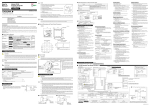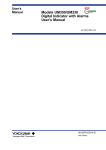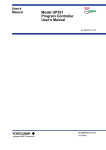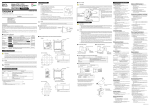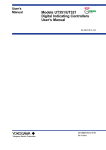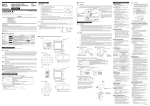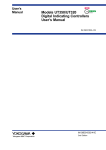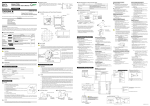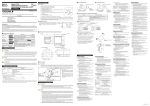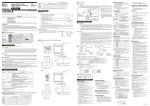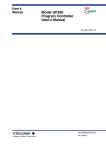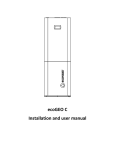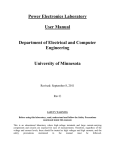Download User`s Manual
Transcript
■ How to Install 3. How to Install User’s Manual Models UM351 / UM331 Digital Indicator with Alarms with Active Color PV Display User’s Manual Installation IM 05F01D12-01E 3rd Edition: Sep 30, 2004 This manual describes installation, wiring, and other tasks required to make the indicator ready for operation. Contents NOTE CAUTION To install the indicator, select a location where: (1) no one may accidentally touch the terminals, (2) mechanical vibrations are minimal, (3) corrosive gas is minimal, (4) temperature can be maintained at about 23°C and the fluctuation is minimal, (5) no direct radiant heat is present, (6) no magnetic disturbances are caused, (7) no wind blows against the terminal board (reference junction compensation element), (8) no water is splashed, (9) no flammable materials are around, Turn off the power to the indicator before installing it on the panel because there is a possibility of electric shock. 150mm 150mm 150mm NOTE Thank you for purchasing the UM351/UM331 digital indicator with alarms. The indicator is shipped from the factory with 4 hardcopy user’s manuals (A2 and A3 size). The 3 user’s manuals in hardcopy format describe the operating procedures required for basic use. It is recommended that you refer to these user’s manuals to understand [1] installation, [2] initial settings, and [3] operating procedures of the indicator. Installation Basic operation Initial Settings Operating procedures and troubleshooting Operations Small bracket CAUTION Install the indicator at an angle within 30° from horizontal with the front panel facing upward. Do not install it facing downward. The position of right and left sides should be horizontal. Front panel of indicator Must not exceed 30 Rear of indicator 30 Description Recommended tightening torque :0.4N m 4. How to Connect Wires ● Installation Position 1) Before carrying out wiring, turn off the power to the indicator and check that the cables to be connected are not alive with a tester or the like because there is a possibility of electric shock. 2) For the protection and safe use of the indicator, be sure to place a circuit breaker (conforms with IEC60947, 5A, 100V or 220V AC) near the indicator where the breaker can easily be operated. In addition, be sure to indicated that it is the instrument to cut the power supply of the indicator. 3) Wiring must be carried out by personnel who have basic electrical knowledge and practical experience. Describes the tasks (installation, wiring, and others) required A2-size paper to make the indicator ready for operations. (Front and back) Describes examples of setting PV input types, and alarm types. Making settings described herein allows you to carry out basic monitoring. Describes examples of setting alarm setpoints, as well as key operation necessary to run the indicator A2-size paper (Front) Contains the parameter map used as a guideline for setting parameters and lists of parameters for recording user settings. A2-size paper (Front and back) (Back) ■ External Dimensions and Panel Cutout Dimensions UM351 Unit: mm 11 Large bracket 100 112 91.8 96 1. Safety Precautions 1) Provide power from a single-phase instrument power supply. If there is a lot of noise in the power line, insert an insulating transformer into the primary side of the line and use a line filter (recommended part: ZAC2205-00U from TDK) on the secondary side. As a countermeasures against noise, do not place the primary and secondary power cables close to each other. 2) For thermocouple input, use shielded compensating lead wires for wiring. For RTD input, use shielded wires that have low conductor resistance and cause no significant differences in resistance between the three wires. The cables to be used for wiring, terminal specifications, and recommended parts are as shown below. 3) Alarm output relays have a life of 100,000 times that of the resistance load, use auxiliary relays to turn on/off a load. 4) The use of inductance (L) loads such as auxiliary relays, motors and solenoid valves causes malfunction or relay failure; always insert a CR filter for use with alternating current or a diode for use with direct current, as a spark-removal surge suppression circuit, into the line in parallel with the load. 5) When there is possibility of being struck by external lightening surge, use the arrester to protect the instrument. The following symbol is indicated on the indicator to ensure safe use. ■ For DC Relay Wiring CAUTION Small bracket 1 to 10 mm (Panel thickness) This symbol on the indicator indicates that the operator must refer to an explanation in the user’s manual in order to avoid the risk of injury or death of personnel or damage to the instrument. The manual describes how the operator should exercise special care to avoid electric shock or other dangers that may result in injury or loss of life. General installation UM351/UM331 [(N-1)96+92] ■ For AC Relay Wiring External DC power supply +0.8 0 +0.8 0 Relay (Use one with a relay coil rating less than the UM’s contact rating.) 145 min. (53) "N" stands for the number of indicators to be installed. However, the measured value applies if N 5. IMPORTANT 92 Draws attention to information that is essential for understanding the operation and/or features of the indicator. +0.8 0 Diode (Mount it directly to the relay coil terminal (socket).) UM’s contact 92 Indicates that operating the hardware or software in a particular manner may damage it or result in a system failure. 92 +0.8 0 Purpose Unit: mm UM331 Shielded compensating lead wires, JIS C 1610, (See Yokogawa Electric's GS 6B1U1-E.) Small bracket 91.8 Optional functions - - Shielded wires (three conductors), UL2482 (Hitachi Cable) Other signals Shielded wires ● Recommended Terminal Lugs 96 Applicable wire size Tightening torque 0.3 to 1.65 mm2 0.8 N·m or less 7 mm or less or 1 to 10 mm (Panel thickness) ● Terminal Covers(Optional parts) Target Model Part Number Sales Unit General installation UM351 T9115YD 1 145 min. UM331 T9115YE 1 Digital indicator with alarms (of ordered model): ......................................... 1 Brackets (mounting hardware): ...................................................................... 1 pair Unit label: ....................................................................................................... 1 User’s Manuals: .............................................................................................. 3 (A2 size) User’s Manuals “Setting/Explanation of Active Color PV Display”: ............ 1 (A3 size) User’s Manual (Reference) (CD-ROM Version) (only for indicators with optional communication functions): ....................... 1 • Purpose: Alarm output, FAIL output, and others • Number of outputs: 4 (Max). • Relay contact rating for Alarm 1 to 3: 240 V AC, 1 A, or 30 V DC, 1 A ; 1a (FAIL output ; 1b) • Relay contact rating for Alarm 4: 250 V AC, 3 A, or 30 V DC, 3 A (resistance load) 3 terminals (NC, NO, Common); 1c CAUTION 70 min. (25) 45 +0.6 0 92 +0.8 0 (53) 1. Before attaching the terminal cover, bend the side with the groove inward as shown in Fig. A. Be careful not to bend it backwards. This not only marks it harder to attach the cover but will also weaken its hold. 2. Fit the holes on the top and bottom (or left and right) of the terminal cover the projections on the brackets (Fig. B) and lock in place. The figure right shows the attachment of a terminal cover to UM indicator. Power supply: Rated voltage of 100 to 240 V AC (10%), 50/60 Hz Power consumption: Max. 20 VA (8.0 W max.) Internal fuse rating: 250 V AC, 1.6A time-lug fuse Data backup: Non-volatile memory (can be written to up to 100,000 times) • Withstanding voltage - Between primary terminals* and secondary terminals**: At least 1500 V AC for 1 minute - Between primary terminals* and grounding terminal: At least 1500 V AC for 1 minute - Between grounding terminal and secondary terminals**: At least 1500 V AC for 1 minute - Between secondary terminals**: At least 500 V AC for 1 minute * Primary terminals indicate power terminals and relay output terminals ** Secondary terminals indicate analog I/O signal, and contact input terminals • Insulation resistance: 20 M or more at 500 V DC between power terminals and grounding terminal • Grounding: Class D grounding (grounding resistance of 100 or less) • PV input terminals: Isolated from other input/output terminals. Not isolated from internal circuit. • 15 V DC loop power supply terminals: Not isolated from 4-20 mA analog output. Isolated from other input/output terminals and internal circuit. • 24 V DC loop power supply terminals: Isolated from 4-20 mA analog output terminals, other input/output terminals and internal circuit. • 4-20 mA analog output terminals (for retransmission): Not isolated from 15 V DC loop power supply. Isolated from other input/output terminals and internal circuit. • Contact input terminals: Not isolated from communication terminals. Isolated from other input/output terminals and internal circuit. • Relay contact output terminals: Not isolated between relay contact output terminals. Isolated from other input/output terminals and internal circuit. • RS-485 communication terminals: Not isolated from contact input terminals. Isolated from other input/output terminals and internal circuit. • Power terminals: Isolated from other input/output terminals and internal circuit. • Grounding terminals: Isolated from other input/output terminals and internal circuit. Environmental Conditions Safety and EMC Standards Check that the following items are provided: • • • • • • Contact Inputs • Purpose: Resetting of PV peak and bottom values • Number of inputs: 1 • Input type: Non-voltage contact or transistor open collector input • Input contact rating: 12 V DC, 10 mA or more • On/off determination: For non-voltage contact input, contact resistance of 1 k or less is determined as “on” and contact resistance of 20 k or more as “off.” For transistor open collector input, input voltage of 2 V or less is determined as “on” and leakage current must not exceed 100 A when “off.” • Minimum status detection hold time: About 1 second • Safety: Compliant with IEC/EN61010-1: 2001, approved by CSA1010, approved by UL508. Installation category : CAT. II (IEC/EN61010, CSA1010) Pollution degree : 2 (IEC/EN61010, CSA1010) Measurement category : I (CAT. I : IEC/EN61010) Rated measurement input voltage : 10V DC max.(across terminals), 300V AC max.(across ground) Rated transient overvoltage : 1500V (Note) Note : It is a value on the safety standard which is assumed by IEC/EN61010-1 in measurement category I, and is not the value which guarantees an apparatus performance. 11 Front of indicator Standard type with three alarms Standard type with three alarms (with 24V DC loop power supply) None With communication and additional alarm-4 With additional alarm-4 • • • • Outputs the PV value. Either the retransmission output or the loop power supply can be used with terminals 16 - 17 . Number of outputs: 1 (terminals 16 - 17 ) Output signal: 4-20 mA DC Load resistance: 600 or less Output accuracy: 0.3% of span under standard operating conditions (23 2C, 55 10% RH, power frequency of 50/60 Hz) • PV display: 4-digit, 7-segment green or red LED display, character height of 20 mm (for both UM351 and UM331) • Setpoint display: 4-digit, 7-segment, red LEDs, character height of 9.3 mm (for both UM351 and UM331) • Status indicating lamps: LEDs 3.7mm Power Supply Specifications • • • • Signal Isolations Retransmission Output Display Specifications 7 mm or less 100 48 Description Digital indicator with Alarms (provided with retransmission output and 15 V DC loop power supply as standard) 0 1 2 X- Small bracket Before using the indicator, check that the model and suffix codes match your order. -0 -3 Power is supplied to a two-wire transmitter. (15 V DC: terminals 16 - 17 ; 24 V DC: terminals 21 - 22 ) A resistor (10 to 250 ) connected between the indicator and transmitter converts a current signal into a voltage signal, which is then read via the PV input terminal . Supply voltage: 14.5 to 18.0 V DC, max. 21 mA (provided with a protection circuit against a field short-circuit); 21.6 to 28.0 V DC, max. 30 mA (only for models with 24 V DC loop power supply) 0 to 40C if the 24V DC loop power supply of Model UM331 is used Contact Outputs RTD 3.7mm Type Loop Power Supply 112 (1) In order to protect the product and the system controlled by it against damage and ensure its safe use, make certain that all of the instructions and precautions relating to safety contained in this document are strictly adhered to. Yokogawa does not guarantee safety if products are not handled according to these instructions. (2) Modification of the product is strictly prohibited. UM331 CR filter (Mount it directly to the relay coil terminal (socket).) Name and Manufacturer (25) ■ Regarding Protection, Safety, and Prohibition Against Unauthorized Modification Suffix Code Relay (Use one with a relay coil rating less than the UM’s contact rating.) Power supply, grounding, relay contact outputs 600 V PVC insulated wires, JIS C 3307, 0.9 to 2.0 mm2 ■ Exemption from Responsibility 2. Model and Suffix Codes UM’s contact ● Cable Specifications and Recommended Cables Thermocouple Make sure that all of the precautions are strictly adhered to. Yokogawa Electric Corporation assumes no liability for any damage resulting from use of the instrument in contradiction to the precautions. Also, Yokogawa Electric Corporation assumes no liability to any party for any loss or damage, direct or indirect, caused by the use or any unpredictable defect of the instrument. External AC power supply R R The following symbols are used in the hardcopy user’s manuals. NOTE UM351/UM331 Relay Side-by-side close installation 117 min. Model Construction, Installation, and Wiring • Construction: Only the front panel is dust-proof and drip-proof (protection class IP55) For side-by-side close installation the indicator loses its dust-proof and drip-proof protection. • Material: ABS resin and polycarbonate • Case color: Black • Weight: About 1 kg or less • Dimensions: UM351 96 (W) 96 (H) 100 (depth from panel face) mm UM331 96(W) 48 (H) 100 (depth from panel face) mm • Installation: Panel-mounting type. With top and bottom (or right and left) mounting hardware (1 each) • Panel cutout dimensions: UM351 92+0.8 (W) 92+0.8 (H) mm 0 0 UM331 92+0.6 (W) 45+0.8 (H) mm 0 0 • Installation position: Up to 30° upward facing (not designed for facing downward) • Wiring: M3.5 screw terminals (for signal wiring and power/ ground wiring as well) NOTE Basic operation of Setting / explanation Describes the setting/explanation of Active Color PV Display. A3-size paper, Active Color PV Display back and front of Active Color PV Display UM351 PV Input Signals • Number of inputs: 1 (terminals 11 - 12 - 13 ) • Input type: Universal input system. The input type can be selected with the software. • Sampling period: 250 ms • Burnout detection: Functions at TC, RTD, standard signal (0.4 to 2 V or 1 to 5 V) Upscale, downscale, and off can be specified. For standard signal, burnout is determined to have occurred if it is 0.1 V or less. • Input bias current: 0.05 A (for TC or RTD b-terminal) • Measurement current (RTD): About 0.13 mA • Input resistance: 1 M or more for thermocouple or mV input About 1 M for DC voltage input • Allowable signal source resistance: 250 or less for thermocouple or mV input Effects of signal source resistance: 0.1 V/ or less 2 k or less for DC voltage input Effects of signal source resistance: About 0.01%/100 • Allowable wiring resistance: for RTD input Maximum 150 /wire: Conductor resistance between three wires should be equal However, 10 /wire for a maximum range of -150.0 to 150.0C. Wire resistance effect: 0.1C /10 • Allowable input voltage: 10 V DC for thermocouple, mV, or RTD input 20 V DC for DC voltage input • Noise rejection ratio: 40 dB (50/60 Hz or more in normal mode 120 dB (50/60 Hz) or more in common mode • Reference junction compensation error: 1.0C (15 to 35C) 1.5C (0 to 15C, 35 to 50C) • Applicable standards: JIS, IEC, DIN (ITS-90) for thermocouples and RTD Media 96 Brief operation Parameters and setpoint recording Insert the indicator into the opening at the front of the panel. Note: Right and left mounting for UM331. ■ How to Use the Manuals Setup Direction to insert the indicator (bottom mounting hardware) Introduction Manual Title (top mounting hardware) 150mm Never touch the opening at the bottom of the case. It is to be used in the factory at shipping. Purpose After opening the mounting hole on the panel, follow the procedures below to install the indicator: 1. Insert the indicator into the opening from the front of the panel so that the terminal board on the rear is at the far Terminal board side. 2. Set the brackets in place on the top and bottom of the indicator as shown in the figure on the left, then tighten the screws Insert a screwdriver into the of the brackets. Take care not to overbrackets to tighten the screws. tighten them. Large bracket Panel Never place the indicator directly on flammable items or equipment. If the indicator has to be installed close to flammable items or equipment, be sure to provide shielding panels all around the indicator, at least 150mm away from every side; the panels should be made of either 1.43mm-thick metal-plated steel plates or 1.6mm-thick uncoated steel plates. 1. Safety Precautions 2. Model and Suffix Codes 3. How to Install 4. How to Connect Wires 5. Hardware Specifications 6. Terminal Wiring Diagrams 5. Hardware Specifications • Normal operating conditions: Ambient temperature: 0 to 50C (40C or less for side-by-side close installation) 0 to 40C if the 24V DC loop power supply of Model UM331 is used Temperature change rate: 10C/h or less Ambient humidity: 20 to 90% RH (no condensation allowed) Magnetic field: 400 A/m or less Continuous vibration at 5 to 14 Hz: Full amplitude of 1.2 mm or less Continuous vibration at 14 to 150 Hz: 4.9 m/s2 or less Short-period vibration: 14.7 m/s2, 15 seconds or less Shock: 147 m/s2 or less, 11 ms Installation height: Height above sea level of 2000 m or less Warm-up time: 30 minutes or more after power on • Transportation and storage conditions: Temperature: -25 to 70C Temperature change rate: 20C/h or less Humidity: 5 to 95% RH (no condensation allowed) • Effects of changes in operating conditions - Effects from changes in ambient temperature: - On voltage or thermocouple input, 1 V/C or 0.01% of F.S./C, whichever is larger - On RTD input, 0.05C /C (ambient temperature) or less - On analog output, 0.05% of F.S./C or less - Effects from power supply fluctuation (within rated voltage range) - On analog input, 1 V/10 V or 0.01% of F.S. /10 V, whichever is larger - On analog output, 0.05% of F.S./ 10 V or less This equipment has Measurement category I, therefore do not use the equipment for measurements within measurement categories II, III and IV. Measurement category 1 Fold the cover in the direction of the arrow. Figure A 2 3 4 Note:Right and left mounting for UM331. Description CAT.1 For measurements performed on circuits not directly connected to MAINS. CAT.2 For measurements performed on circuits directly connected to the low voltage installation. CAT.3 For measurements performed in the building installation. CAT.4 For measurements performed at the source of the low-voltage installation. Fit the cover hold over the protrusion on the mounting bracket. Remarks Appliances, portable equipments, etc. Distribution board, circuit breaker, etc. Overhead wire, cable systems, etc. Internal Wiring 3 Entrance 4 Cable 2 T 1 Outlet Figure B • EMC standards: Complies with EN61326. The instrument continues to operate at a measuring accuracy of within 20% of the range during tests. IM 05F01D12-01E (1) 6. Terminal Wiring Diagrams NOTE Do not use unassigned terminals as relay terminals. ■ UM351 Standard Type (Model UM351-䊐䊐) RS-485 communication 23 SDB(+) 24 PV input * Wiring can only be carried out for indicators with communication functions. Maximum baud rate: 9600 bps * Wiring can only be carried out for indicators with 24 V DC loop power supply. 24 V DC loop power supply SDA(-) 䊏 Receiving 4-20 mA DC Current Signals with the Indicator * Not configured at factory before shipment See Initial Settings User’s Manual , for more information. * When receiving 4-20 mA DC current signals, set the PV input type to 1-5 V DC (setpoint “41”). RTD input TC input 11 A 12 + 25 RDB(+) Alarm 4 output 26 RDA(-) 27 SG 21 + 22 - 12 + 12 b 250 Ω 4-20mA 13 - 21.6-28.0VDC (30 mA DC max.) 13 - 13 B mV/V input Note: Connecting a 250 Ω resistor to the terminals is optional. Model: X010-250-2 (resistor with M3.5 crimp-on terminal lugs) Relay contact output NC 1 NO 2 COM 3 * Wiring can only be carried out for UM351-ⵧ1 or UM351-ⵧ2. Contact rating: 250 V AC, 3 A 30 V DC, 3 A (resistance load) Power supply CAUTION Before carrying out wiring, turn off the power to the indicator and check that cables to be connected are not alive with a tester or the like because there is a possibility of electric shock. Power supply L N 8 12 + 1 21 11 2 22 12 3 23 13 4 24 5 25 6 26 16 16 + 7 27 17 17 - 13 - Retransmission output * PV retransmission is configured at factory before shipment. 4-20 mA DC Load resistance: 600 Ω or less 8 9 9 19 10 10 20 * If 15 V DC loop power supply is used, retransmission output cannot be used. 15 V DC loop power supply 16 + Allowable range: 100 to 240 V AC (10%) (free voltage) 50/60 Hz shared 14.5-18.0VDC (21 mA DC max.) 17 Alarm output Alarm 1 output AL1 6 Alarm 2 output AL2 5 UM Contact input Relay Alarm 3 output AL3 4 Common COM 7 Resets the PV peak and bottom values when DI1 is changed from OFF to ON. UM DI1 19 Common COM 20 Contact +5V Transistor contact DI1 19 COM Relay contact rating: 240 V AC, 1 A 30 V DC, 1 A (resistance load) 20 Contact rating: 12 V DC, 10 mA or more ■ UM331 Standard Type (Model UM331-䊐䊐) 䊏 Receiving 4-20 mA DC Current Signals with the Indicator * When receiving 4-20 mA DC current signals, set the PV input type to 1-5 V DC (setpoint “41”). PV input 12 + 250 Ω 4-20mA * Not configured at factory before shipment See Initial Settings User’s Manual , for more information. TC input 13 - RTD input Retransmission output 11 A 12 + 16 + 12 b Note: Connecting a 250 Ω resistor to the terminals is optional. Model: X010-250-2 (resistor with M3.5 crimp-on terminal lugs) 4-20 mA DC 13 - 17 - Load resistance: 600 Ω or less 13 B mV/V input * Wiring can only be carried out for indicators with 24 V DC loop power supply. 24 V DC loop power supply 21.6-28.0VDC (30 mA DC max.) 15 V DC loop power supply 12 + 16 + 13 - 17 - + 21 11 12 13 14.5-18.0VDC (21 mA DC max.) 16 17 3 UM DI1 19 Common COM 20 Contact +5V Transistor contact DI1 19 20 Contact rating: 12 V DC, 10 mA or more RS-485 communication * Wiring can only be carried out 27 23 SDB(+) Alarm 4 output COM Contact input Resets the PV peak and bottom values when DI1 is changed from OFF to ON. 19 20 - 22 1 Relay contact output * Wiring can only be carried out for UM331-ⵧ1 or UM331-ⵧ2. NC 1 2 * If 15 V DC loop power supply is used, retransmission output cannot be used. COM 21 22 23 24 25 26 NO * PV retransmission is configured at factory before shipment. 2 3 4 5 6 7 8 9 24 10 for indicators with communication functions. Maximum baud rate: 9600 bps SDA(-) 25 RDB(+) 26 RDA(-) 27 SG Power supply Contact rating: 250 V AC, 3 A 30 V DC, 3 A (resistance load) Power supply Alarm output Alarm 1 output L UM AL1 6 N Relay Alarm 2 output AL2 5 Alarm 3 output AL3 4 Common 8 9 10 CAUTION Before carrying out wiring, turn off the power to the indicator and check that cables to be connected are not alive with a tester or the like because there is a possibility of electric shock. Allowable range: 100 to 240 V AC (10%) (free voltage) 50/60 Hz shared COM 7 Relay contact rating: 240 V AC, 1 A 30 V DC, 1 A (resistance load) * Wiring can only be carried out for indicators with 24 V DC loop power supply. 15 V DC Power Supply Wiring to Two-wire Sensor 24 V DC Power Supply Wiring to Two-wire Sensor 12 External resistor 100 (Note) Two-wire transmitter 12 External resistor 250 (Note) PV input 0.4 to 2.0 V DC signal 13 16 4-20mADC 17 Two-wire transmitter Loop power supply 14.5 to 18.0 V DC Note: Connecting a 100 resistor to the terminals is optional. Model: X010-100-2 (resistor with M3.5 crimp-on terminal lugs) PV input 1 to 5 V DC signal 13 21 4-20mADC 22 Loop power supply 21.6 to 28.0 V DC Note: Connecting a 250 resistor to the terminals is optional. Model: X010-250-2 (resistor with M3.5 crimp-on terminal lugs) IM 05F01D12-01E (2) Press the 3. User’s Manual key once to register the setpoint. SET/ENT Models UM351 / UM331 Digital Indicator with Alarms with Active Color PV Display User’s Manual Initial Settings IM 05F01D12-02E 8. SET/ENT Press the key once to display the parameter “RL” (minimum value of PV input range). PV AL1 2 3 4 AL1 SET/ENT 3rd Edition: Sep 30, 2004 4. Press the key once to display the parameter “UNIT” (PV input unit). 9. Displays parameter “UNIT”. PV SET/ENT 2 3 4 AL1 2 3 Press the or key to display the required setpoint. The figure below shows an example of setting the minimum value of PV input range to 0.0°C. AL1 2 3 4 Blinks during change. SET/ENT Press the key once to display the parameter “RH” (maximum value of PV input range). 10. Press the SET/ENT The following operating procedure describes an example of changing PV input terminal the setting of K-type thermocouple (-199.9 to 500.0⬚C) to RTD Pt100 Thermocouple/mV/V input.............................. 12 - 13 RTD input .................................................. 11 - 12 - 13 (-199.9 to 500.0⬚C) and a measurement range of 0.0 to 200.0⬚C. 1. Bring the operating display into view (display appears at power on). AL1 2 3 3. Alarm indicator lamps 3. Alarm indicator lamps 5. and AL1 4. SET/ENT key 2. Parameter Setpoint display PV 2 3 4 Function Parameter setpoint display Displays the setpoint of a parameter when it is configured. 3. Alarm indicator lamps 2 3 4. SET/ENT key 5. and keys AL1 2 3 AL1 7. key once to register the setpoint. SET/ENT Used to switch or register a parameter. Pressing the key for more than 3 seconds allows you to switch between the operating display and the menu for operating parameter setting display alternately. 2. 2 3 2 3 Press the “STUP”. 4 PV 12. OFF 1 2. Setting PV Input Type (Setting First at Power-on) K NOTE 2 3 The indicator displays the operating display when the power is turned on. However, if PV input type has not key to been set, “IN” appears. In this case, first use the display the input range code to use, then press the key NOTE to register it. Then, set the maximum value (RH) and minimum If the display is as shown on the left, value (RL) of the PV input range (for voltage input, set the press the key to show the range code for the PV input type you maximum value (SH) and minimum value (SL) of the PV input use. Then, register the range code scale). setting by pressing the key. The indicator is configured to the initial value of each parameter at the factory before shipment. First check the initial values shown in 2. Lists of Parameters, in Parameters User’s Manual and change parameter values as necessary. J SET/ENT 3 4 5 PV 2 T 6 4 SET/ENT SET/ENT • B 7 S 8 R Example of Temperature Input -200°C Example of Voltage Input 1V 1370°C 2V 4V Set the actual read-out range. 0°C 800°C Minimum value of PV input range (RL) Maximum value of PV input range (RH) PV input range RL Parameters to be set for temperature input 1. PV input type (IN): Set according to a sensor 2. Maximum value of PV input range (RH): Set the maximum value of the range to be displayed. 3. Minimum value of PV input range (RL): Set the minimum value of the range to be displayed. (input signal) RH N 10 E 11 L(DIN) 12 Set the actual read-out range. PV input scale 13 U(DIN) 0.0m3/h 50.0m3/h Minimum value of PV input scale (SL) Maximum value of PV input scale (SH) 14 Parameters to be set for voltage input 1. PV input type (IN): Set according to an input signal 2. Maximum value of PV input range (RH): Set the maximum value of an input signal. 3. Minimum value of PV input range (RL): Set the minimum value of an input signal. 4. Position of PV input decimal point (SDP): Set the position of the decimal point for PV input display. 5. Maximum value of PV input scale (SH): Set the maximum value of the scale to be displayed. 6. Minimum value of PV input scale (SL): Set the minimum value of the scale to be displayed. W 15 Platinel 2 16 PR20-40 17 W97Re3W75Re25 The following operating procedure describes an example of setting a K-type thermocouple (-199.9°C to 500.0°C) and a measurement range of 0.0°C to 200.0°C. 1. Display screen at power-on The parameter “IN” for setting the PV input type appears. Displays parameter“IN”. PV AL1 SET/ENT 2 3 2. 9 Thermocouple Instrument input range Instrument input range PV input range 5V Press the or key to display the required setpoint. The figure below shows an example of setting a K-type thermocouple (-199.9 to 500.0°C). See the Instrument Input Range Codes. 18 30 JPt100 31 RTD 35 Pt100 36 37 PV Blinks during change. AL1 4 SET/ENT 2 3 3 Standard signal 4 DC voltage 0.4 to 2 V 1 to 5 V 0 to 2 V 0 to 10 V -10 to 20 mV 0 to 100 mV 40 41 50 51 55 56 4 Press the or key to display the required setpoint. The figure below shows an example of setting PV low limit alarm. 4 AL1 2 3 4 Blinks during change. SET/ENT 2 3 Press the “STUP”. key once to display the menu The PV display in the figure above shows the error code for input burnout ( ) if PV input wiring is not yet complete. The error code disappears when you wire the PV input terminals correctly. 2 * Performance in the standard condition (at 23⫾2⬚C, 55⫾10%RH, and 50/60Hz power frequency. Note1: The accuracy is ⫾0.3⬚C of instrument range ⫾1 digit for a temperature range from 0⬚C to 100⬚C. Note2: The accuracy is ⫾0.5⬚C of instrument range ⫾1 digit for a temperature ranges from -100⬚C to 0⬚C and 100⬚C to 200⬚C. * To receive a 4-20 mA DC signal, select a standard signal of 1 to 5 V DC and connect it to a 250⍀ resistor. This resistor is optional. Model: X010-250-2 (resistor with M3.5 crimp-on terminal lugs) Press the key once to register the setpoint. SET/ENT Display menu “STUP”. PV 4 3 AL1 4 2 3 2 3 4 AL1 4. Press the “PWD”. SET/ENT Press the “FUNC”. 3 4 You can take the same steps for alarm-2 type (AL2), alarm-3 type (AL3), and alarm-4 type (AL4) that are displayed after this. Press the “PWD”. SET/ENT key once to display the parameter key once to display the parameter 9. Blinks during change. 13. Press the SET/ENT Press the key for more than 3 seconds. This returns you to the display shown at power-on (figure below). SET/ENT Displays parameter “PWD”. PV 2 3 PV 4 Displays parameter “PWD”. 2 3 Displays PV. AL1 2 3 4 key once to register the setpoint. SET/ENT SET/ENT 2 SET/ENT 4 SET/ENT AL1 Instrument Measurement Accuracy Input Range Set the data item PV Input Type "IN" to the OFF option to leave the PV input type undefined. -200 to 1370⬚C -300 to 2500⬚F -199.9 to 999.9⬚C 0 to 2300⬚F ⫾0.1% of instrument range ⫾1 digit for temperatures -199.9 to 500.0⬚C equal to or higher than 0⬚C -199.9 to 999.9⬚F ⫾0.2% of instrument range ⫾1 digit for temperatures -199.9 to 999.9⬚C below 0⬚C -300 to 2300⬚F -199.9 to 400.0⬚C -300 to 750⬚F 0.0 to 400.0⬚C -199.9 to 750.0⬚F ⫾0.15% of instrument range ⫾1 digit for temperatures 0 to 1800⬚C equal to or higher than 400⬚C 32 to 3300⬚F ⫾5% of instrument range ⫾1 digit for temperatures below 400⬚C 0 to 1700⬚C 32 to 3100⬚F ⫾0.15% of instrument range ⫾1 digit 0 to 1700⬚C 32 to 3100⬚F ⫾0.1% of instrument range ⫾1 digit -200 to 1300⬚C ⫾0.25% of instrument range ⫾1 digit for temperatures -300 to 2400⬚F below 0⬚C -199.9 to 999.9⬚C -300 to 1800⬚F -199.9 to 900.0⬚C ⫾0.1% of instrument range ⫾1 digit for temperatures -300 to 1300⬚F equal to or higher than 0⬚C ⫾0.2% of instrument range ⫾1 digit for temperatures -199.9 to 400.0⬚C below 0⬚C -300 to 750⬚F 0.0 to 400.0⬚C -199.9 to 750.0⬚F 0 to 2300⬚C ⫾0.2% of instrument range ⫾1 digit 32 to 4200⬚F 0 to 1390⬚C ⫾0.1% of instrument range ⫾1 digit 32 to 2500⬚F ⫾0.5% of instrument range ⫾1 digit for temperatures 0 to 1900⬚C equal to or higher than 800⬚C 32 to 3400⬚F No guarantee of accuracy for temperatures below 800⬚C 0 to 2000⬚C ⫾0.2% of instrument range ⫾1 digit 32 to 3600⬚F -199.9 to 500.0⬚C ⫾0.1% of instrument range ⫾1 digit (Note1) (Note2) -199.9 to 999.9⬚F -150.0 to 150.0⬚C ⫾0.2% of instrument range ⫾1 digit (Note1) -199.9 to 300.0⬚F -199.9 to 850.0⬚C -300 to 1560⬚F ⫾0.1% of instrument range ⫾1 digit (Note1) (Note2) -199.9 to 500.0⬚C -199.9 to 999.9⬚F -150.0 to 150.0⬚C ⫾0.2% of instrument range ⫾1 digit (Note1) -199.9 to 300.0⬚F 0.400 to 2.000 V 1.000 to 5.000 V ⫾0.1% of instrument range ⫾1 digit (Note) 0.000 to 2.000 V The read-out range can be scaled between -1999 and 0.00 to 10.00 V 9999. -10.00 to 20.00 mV 0.0 to 100.0 mV 8. PV SET/ENT Select the unit from the UNIT parameter. AL1 2 PV 4. Displays menu “STUP”. AL1 ■ Instrument Input Range Codes Unspecified 3 PV Press the or key to display the required setpoint. The figure below shows an example of setting the maximum value of PV input range to 200.0°C. 5. PV AL1 4 2 3 Press the “FUNC”. SET/ENT SET/ENT key once to display the menu See “1. Setting an Alarm Setpoint” in Operations User’s Manual when setting an alarm setpoint. 4 Displays menu “FUNC”. SET/ENT SET/ENT Instrument Input Range Code 2 SET/ENT PV 3 3. Displays parameter “RH”. AL1 key once to display the menu Displays PV. 5. Type 7. Displays menu “OP.PA”. PV PV Input AL1 SET/ENT 3. 4 IMPORTANT • 4 SET/ENT AL1 The indicator automatically returns to the display at the time of power-on (i.e., Operating display) if no key is operated for at least one minute. 3 Displays parameter “AL1”. PV SET/ENT 4 PV AL1 2 Press the key for more than 3 seconds to call up the menu “OP.PA”. AL1 SET/ENT 2 Press the key once to display the parameter “RH” (maximum value of PV input range). SET/ENT key for more than 3 seconds. This returns you to the display shown at power-on (figure below). AL1 11. Displays menu “OP.PA”. AL1 SET/ENT The following explanation of operation for the UM351’s panel, shown in the figure, is the same as that of the UM331’s panel. 2 SET/ENT SET/ENT PV PV Used to change numerical values. On setting displays for various parameters, you can change parameters, setpoint. Pressing the key decreases a numerical value, while pressing the key causes it to increase. You can hold down a key to gradually increase the speed of change. 7 SET/ENT AL1 Press the 1 7 4 4 SET/ENT If any of alarms 1 to 4 occurs, the respective alarm indicator lamp (AL1 to AL4) is lit (in orange). SET/ENT 11. Press the Blinks during change. SET/ENT • Displays a PV value during operation. • Displays a parameter symbol when you set a parameter. • Displays an error code in red if the indicator fails. 2. SET/ENT 4 SET/ENT PV AL1 Name of Part Process variable (PV) display 3 keys 4. SET/ENT key 1. 2 Press the key for more than 3 seconds to call up the menu “OP.PA”. SET/ENT Press the or key to display required the setpoint. The figure below shows an example of setting the maximum value of PV input range to 200.0°C. keys 4 Factory-set defaults )............PV high limit alarm )............PV low limit alarm )............PV high limit alarm - 3 )......PV low limit alarm Press the key once to display the parameter “AL1” (alarm-1 type). SET/ENT 2. If the type of input is voltage, also configure the PV Input Decimal Point Position (SDP), Maximum value of PV Input Scale (SH), and Minimum value of PV Input Scale (SL) parameters that are displayed after this. 6. 5 7 PV 4 1. Process variable (PV) display UM331 2. Parameter Setpoint display and key once to register the setpoint. Press the key once to display the parameter “UNIT” (PV input unit). Displays parameter PV “UNIT”. SET/ENT SET/ENT 5. 10. Displays PV. AL1 Displays parameter “RH”. PV UM351 6. Displays PV. PV AL1 1. Names and Functions of Front Panel Parts 1. Process variable (PV) display Bring the operating display into view (appears at power-on). SET/ENT 4 SET/ENT 1. Names and Functions of Front Panel Parts 2. Setting PV Input Type (Setting First at Power-on) 3. Changing PV Input Type 4. Changing Alarm Type 5. Setting Hysteresis in Alarm Setpoint 1. 3. Changing PV Input Type PV 5. Alarm-4 (terminal numbers - 6 PV SET/ENT Contents The following operating procedure describes an example of changing Alarm output terminals alarm-1 (factory-set value: PV high limit alarm) to PV low limit alarm. Alarm-1 (terminal numbers When you have changed alarm type, the alarm setpoint will be initial- Alarm-2 (terminal numbers Alarm-3 (terminal numbers ized; set the alarm setpoint again. SET/ENT SET/ENT This manual describes examples of setting the types of PV input and alarm. Carrying out settings described herein allows you to perform basic monitoring. Refer to examples of various settings to understand how to set parameters required. Refer to “1. Parameter Map” in Parameters User’s Manual for an easy to understand explanation of setting various parameters. If you cannot remember how to carry out an operation during setting, press the key for more than 3 seconds. This brings you to the display (operating display) that appears at power-on. The indicator may automatically initialize the registered operating parameter setpoints if any change is made to the data item PV Input Type (IN), Maximum Value of PV Input Range (RH), Minimum Value of PV Input Range (RL), PV Input Decimal Point Position (SDP), Maximum Value of PV Input Scale (SH) or Minimum Value of PV Input Scale (SL). After a change has been made to any of these data items, be sure to verify the registered operating parameter setpoints to ensure that they are correct. If any data item has been changed to its default, set it to a required value. Displays parameter “RL”. PV 4. Changing Alarm Type NOTE key once to display the menu 14. Press the key once to display the parameter “RL” (minimum value of PV input range). Displays menu “FUNC”. PV AL1 2 3 2 3 4 SET/ENT PV 4 SET/ENT Displays parameter “RL”. AL1 2 3 5. Setting Hysteresis in Alarm Setpoint 4 The following operating procedure describes an example of setting a 5.0°C hysteresis level in the alarm setpoint. SET/ENT SET/ENT 1. 6. Press the key once to display the menu “I/O”. 15. Press the or key to display the required setpoint. The figure below shows an example of setting the minimum value of PV input range to 0.0°C. 6. Press the key several times to display the parameter “HY1” (alarm-1 hysteresis). SET/ENT Displays PV. PV AL1 Displays menu “I/O”. PV Bring the operating display into view (appears at power-on). 2 3 4 AL1 2 3 AL1 4 2 3 Press the key once to display the parameter “IN” (PV input type). SET/ENT 16. Press the SET/ENT Blinks during change. 2. Press the key for more than 3 seconds to call up the menu “OP.PA”. SET/ENT key once to register the setpoint. 7. Press the setpoint. or Displays menu “OP.PA”. PV 2 3 2 3 4 AL1 4 AL1 SET/ENT Press the or key to display the required setpoint. The figure below shows an example of changing to RTD Pt100 (-199.9 to 500.0°C). Blinks during change. AL1 2 3 17. 2 3 Press the “STUP”. Blinks during change. SET/ENT key once to display the menu SET/ENT 8. Press the SET/ENT AL1 Displays PV. PV AL1 2 3 Display menu “STUP”. PV key once to register the setpoint. 2 3 PV 4 AL1 SET/ENT 2 3 4 SET/ENT You can take the same steps for alarm-2 hysteresis (HY2), alarm-3 hysteresis (HY3), and alarm-4 hysteresis (HY4) that are displayed after this. 4 SET/ENT 4. SET/ENT 4 4 Press the key for more than 3 seconds. This returns you to the display shown at power-on (figure below). 4 SET/ENT Press the 3 SET/ENT PV 9. 2 PV 3. 8. key to display the required PV SET/ENT AL1 4 SET/ENT AL1 Displays parameter “IN”. PV 3 4 SET/ENT SET/ENT 7. 2 PV SET/ENT AL1 Displays parameter “HY1”. PV key once to register the setpoint. PV * If the type of input is voltage, also configure the PV Input Decimal Point Position (SDP), Maximum value of PV Input Scale (SH), and Minimum value of PV Input Scale (SL) parameters that are displayed after patameter RL. Press the “PWD”. SET/ENT key once to display the parameter Displays parameter “PWD”. PV AL1 AL1 2 3 2 3 9. Press the key for more than 3 seconds. This returns you to the display shown at power-on (figure below). SET/ENT PV 4 Displays PV. AL1 2 3 4 4 SET/ENT SET/ENT SET/ENT 5. Press the “FUNC”. SET/ENT key once to display the menu Displays menu “FUNC”. PV AL1 2 3 4 SET/ENT IM 05F01D12-02E (1) 2. Troubleshooting User’s Manual Models UM351 / UM331 Digital Indicator with Alarms with Active Color PV Display User’s Manual Operations IM 05F01D12-02E ■ Troubleshooting Flow If the operating display does not appear after turning on the indicator's power, try to solve the problem by following the procedure below. If the problem seems to be complex, contact the vendor from which you purchased the instrument. Is the instrument defective? Yes 3rd Edition: Sep 30, 2004 No Totally inoperable? Yes This manual describes key entries for operating the indicator. If you cannot remember how to carry out an operation during setting, press the key for more than 3 seconds. This brings you to the display (operating display) that appears at power-on. SET/ENT No Is key operation faulty? Yes Check wiring on the power supply terminals. No Is display faulty? Yes Check the key lock setting. Is communication link faulty? No Yes Turn off power, and then turn it on again. Yes Check the instrument’s I/O specifications. Check the supply voltage. Check the instrument's suffix code. No Check the specifications of I/O counterpart for wrong polarity. No Contents No communication capability. Normal? No 1. 2. Is I/O signal faulty? Setting Alarm Setpoints Troubleshooting Is key lock enabled? Yes Correct errors. Check the specifications of communication counterpart. Correct? Yes Yes Do not use the instrument genarating strong magnetic field such as radio equipment and the like near the indicator. This may cause the fluctuation of the PV value. Ask the vendor for repair. Check the communication-related parameters. Check communication wiring. No NOTE Does the code include a communication option? Disable key lock. Find the cause. 1. Setting Alarm Setpoints The following operating procedure describes an example of setting Alarm output terminals Alarm-1 (terminal numbers a value of 160.0 in the alarm 1 setpoint parameter. Before setting Alarm-2 (terminal numbers the alarm setpoint, check the alarm type. To change the alarm type, Alarm-3 (terminal numbers see “4. Changing Alarm Type” in Initial Settings User's Alarm-4 (terminal numbers Manual . Factory-set defaults - 7 )............PV high limit alarm - 7 )............PV low limit alarm - 7 )............PV high limit alarm - 2 - 3 ).......PV low limit alarm 6 5 4 1 IMPORTANT Take note of the parameter settings when asking the vendor for repair. ■ Errors at Power On 1. Bring the operating display into view (display appears at power on). 4. Press the setpoint. or AL1 2 3 AL1 4 2 3 4 Blinks during change. SET/ENT Press the key for more than 3 seconds to call up the menu “OP.PA”. SET/ENT 5. Press the SET/ENT Displays menu “OP.PA”. PV AL1 2 3 Description of error PV Control output Alarm output Retransmission Communioutput cation Remedy PV SET/ENT 2. The following table shows errors that may be detected by the fault diagnosis function when the power is turned on. Error indication (on PV display unit) Displays PV. PV key to display the required key once to register the setpoint. PV 4 Faulty RAM (E001) Faulty ROM (E002) System data error 0% PV decimal point blinks. (E400) AL1 SET/ENT (E000) 2 3 Faulty calibration value Parameter error None 0% or less 0% or less or OFF Stopped OFF 0% Normal action Normal action Normal action Normal action Normal (out of (out of (out of (out of action accuracy) accuracy) accuracy) accuracy) 0% Preset value OFF Faulty Contact us for repair. Check and set the parameters, as they have been set to the limited values. 0% 4 SET/ENT ■ Possible Errors during Operation You can take the same steps for alarm-2 setpoint (A2), alarm-3 setpoint (A3), and alarm-4 setpoint (A4) that are displayed after this. 3. Press the “A1”. SET/ENT key once to display the parameter Displays parameter “A1”. PV AL1 SET/ENT 2 3 6. Press the key for more than 3 seconds. This returns you to the display shown at power-on (figure below). SET/ENT Displays PV. PV 4 The following shows possible errors occurring during operations. Error indication Description (on PV display of error unit) PV Displays “RJC” and PV alternately RJC error PV value blinks. EEPROM error AL1 2 3 Alarm output Retransmis- Commusion output nication Measured with RJC=OFF Normal action Normal action Normal action Normal action Faulty Contact us for repair. Normal action Normal action Normal action Normal action Faulty Contact us for repair. 105% Preset value Normal action Normal action Normal action Dependent on the BSL parameter Up-scale: 105% Down-scale: -5% Preset value Normal action Normal action Normal action Check wires and sensor. Normal action Normal action Normal action Normal action Check process. Normal action Normal action Normal action Normal action Check wires and communication parameters, and make resetting. Recovery at normal receipt Normal action Control output Remedy 4 SET/ENT (E300) A/DC error (B.OUT) PV burnout error (OVER) or Excessive PV -5% or 105% (-OVER) Out of -5 to 105% SP decimal pont Faulty blinks (on communisetpoint display cation line unit). Normal action All indications off Runaway (due None to defective power or noise) 0% or less OFF or OFF 0% or less Stopped Faulty if power off/on does not reset start the unit. Contact us for repair. All indications off Power off 0% 0% Stopped Check for abnormal power. None OFF ■ If a Power Failure Occurs during Operation ● Momentary power failures shorter than 20 ms The indicator is not affected at all and continues normal operation. ● Momentary power failures of 20 ms or longer • The alarm function of the indicator continues to work normally. (Alarms with the stand-by feature temporarily return to their stand-by state, however.) • Setting parameters that have already been configured retain their settings. IM 05F01D12-02E (2) User’s Manual Models UM351 / UM331 Digital Indicator with Alarms with Active Color PV Display User’s Manual Parameters IM 05F01D12-03E Basic Key Operation Sequence 3rd Edition: Sep 30, 2004 1. Setting display can be switched (moved) using the SET/ENT key. 2. A numerical value is changed by (1) Using the This manual contains a parameter map as a guideline for setting parameters, and lists of parameters for recording User Settings. ? Contents key to change a displayed value (decimal point blinking) and key to register it. SET/ENT SET/ENT 3. Pressing the key on an operating display (for more than 3 seconds) brings you to the operating parameter setting display. If you become unsure of key operation during parameter setting, hold down the key for more than 3 seconds. This returns you to the display at power-on (i.e., operating display). 4. Pressing the key on the operating parameter setting display (for more than 3 seconds) returns you to the operating display. SET/ENT SET/ENT 1. Basic Key Operation Sequence and Parameter Map 2. Lists of Parameters or (2) Pressing the 5. Pressing the key on the setup parameter setting display (for more than 3 seconds) returns you to the operating display. You cannot return to the operating parameter setting display from the setup parameter setting display. SET/ENT 1. Basic Key Operation Sequence and Parameter Map Power on Determine PV input type first. Display example Display example PV No Yes Display? IN = OFF Blinks during change. PV AL1 2 3 4 AL1 SET/ENT C Settings herein are described in “2. Setting PV Input Type (Setting First at Power-on) ” in Initial Settings User’s Manual . 2 3 PV 4 SET/ENT AL1 2 3 A 4 or key to set a numerical value. See Instrument Input Range Codes in Initial Settings User’s Manual . 2. Press the SET/ENT C After PV input type (IN), input/output parameters such as PV input unit (UNIT), maximum value of PV input range (RH), and minimum value of PV input range (RL) will be displayed. SET/ENT 1. Use the B key to register the value. NOTE Changing the registered value of a setup parameter may cause the registered value of an operating parameter to be initialized automatically. Thus, when you have changed a setup parameter, always check that the registered value of the operating parameter is appropriate. If it is initialized to default, reset it to the required value. key SET/ENT Press this key for more than 3 seconds to move to the operating display. Operating Display Displays PV A PV AL1 2 3 Displayed first after power on. Setup Parameter Setting Display 4 SET/ENT Alarm/Communication related Input related Description of Setup Parameter Menu Display or key SET/ENT SET/ENT key Displays a menu, such as FUNC or I/O. key Menu SET/ENT key SET/ENT Press this key for more than 3 seconds to move to the operating parameter setting display. key PV color mode PV input type (PV INPUT terminals) Alarm-1 type PV input unit AL1 Press this key for more than 3 seconds to move to the operating display. Alarm-2 type Maximum value of PV input range Alarm-3 type Minimum value of PV input range Menu Alarm-4 type Operating Parameter Setting Display or Description of Operating Parameter Menu Display key key SET/ENT key Alarm-1 setpoint Password input Displays the operating parameter menu symbol “OP.PA.” Alarm-3 setpoint SET/ENT B PV bottom value AL1 2 3 Alarm-3 hysteresis Presence/absence of PV input reference junction compensation Nothing is displayed. Description of Setup Parameter Setting Display Displays a parameter. PV AL1 2 3 4 Displays a setpoint. SET/ENT External RJC setpoint (displayed when IN=TC) Alarm-1 delay timer Selection of PV input burnout action Alarm-2 delay timer Retransmission output type Alarm-3 delay timer Maximum value of retransmission output scale Alarm-4 delay timer Description of Operating Parameter Setting Display Displayed only for UM351-ⵧ1, UM351-ⵧ2, UM331-ⵧ1, UM331-ⵧ2. Minimum value of retransmission output scale Protocol selection DI function selection Baud rate SELECT display-1 registration Parity SELECT display-2 registration PV 2 3 4 Displays a setpoint. PV input bias Stop bit SET/ENT Displayed when PCMD (PV color mode parameter) = 6 or 7 SET/ENT Displayed only for UM351-ⵧ1, UM351-ⵧ2, UM331-ⵧ1, UM331-ⵧ2. 4 key AL1 To switch the parameter display, press the 4 Nothing is displayed. Displays a parameter symbol. PV input filter SET/ENT Alarm-2 hysteresis Minimum value of PV input scale (displayed at voltage input) Displayed only for UM351-ⵧ1, UM351-ⵧ2, UM331-ⵧ1, UM331-ⵧ2 PV peak value Low limit for PV color change Maximum value of PV input scale (displayed at voltage input) Alarm-4 hysteresis SET/ENT High limit for PV color change 3 PV input decimal point position (displayed at voltage input) Displayed only for UM351-ⵧ1, UM351-ⵧ2, UM331-ⵧ1, UM331-ⵧ2. Alarm-1 hysteresis PV (No password is required when PWD = 0.) Alarm-2 setpoint Alarm-4 setpoint 2 SET/ENT Menu SET/ENT PV Displayed only for indicators with communication functions SELECT display-3 registration Data length SELECT display-4 registration Address Key lock Minimum response time Password setting key. key This parameter is not to be set. SET/ENT SET/ENT key key IM 05F01D12-03E (1) 2. Lists of Parameters * Parameters relating to PV should all be set in real numbers. For example, use temperature values to define alarm setpoints for temperature input. Name of Parameter Alarm 1-setpoint Setting Range and Description Initial Value PV alarm: -100.0 to 100.0% of PV input range User setting PV high limit alarm: 100.0% of PV input range PV low limit alarm: 0.0% of PV input range (A1) Alarm 2-setpoint (A2) Alarm 3-setpoint (A3) Parameter Symbol Name of Parameter Setting Range and Description (IN) PV input type (PV INPUT terminals) 11 - 12 - 13 terminals PV input unit OFF, 1 to 18, 30, 31, 35 to 37, 40, 41, 50, 51, 55, 56 See Instrument Input Range Codes in Initial Settings User’s Manual . °C: degree Celsius °F: Fahrenheit Max. value of PV input range (RH) Alarm 4-setpoint Min. value of PV input range PV peak value Displays the maximum value of PV input during operation. This parameter is not to be set. PV bottom value Displays the minimum value of PV input during operation. This parameter is not to be set. (RL) (PEAK) (SDP) (BOTM) PV input filter OFF, 1 to 120 second Used when the PV input fluctuates. OFF PV input bias -100.0% to 100.0% of PV input range span Used to correct the PV input value. 0.0% of PV input range span High limit for PV color change When PCMD (PV color mode parameter) = 6 or 7 : -100.0 to 100.0 % of PV input range (FL) (BS) (SH) When PCMD = 6 or 7 : PCCH = 100.0%, PCCL = 0.0 % (PCCH) (SL) Low limit for PV color change (BSL) (PCCL) ■ Setup Parameters (RJC) ● Alarm/Communication-related Parameters Name of Parameter Initial Value OFF Alarm type code User Setting Alarm type “Open/close” shows status of relay contact, and “lit” and “unlit” shows status of lamp °C PV input decimal point position (displayed at voltage input) Set the PV input range, however RL < RH -Temperature input Set the range of temperature that is actually indicated. - Voltage input Set the range of a voltage signal that is applied. The scale across which the voltage signal is actually indicated should be set using the parameters Maximum Value of PV Input Scale (SH) and Minimum Value of PV Input Scale (SL). 0 to 3 Set the position of the decimal point of voltagemode PV input. 0: No decimal place 1: One decimal place 2, 3: Two, three decimal places -1999 to 9999, however SL < SH Set the read-out scale of voltage-mode PV input. Max. value of PV input scale (displayed at voltage input) Min. value of PV input scale (displayed at voltage input) Selection of PV input OFF burnout action 1: Up scale 2: Down scale OFF, ON Presence/absence of PV input reference junction compensation External RJC setpoint -50.0 to 50.0 ⬚C -58.0 to 122.0 ⬚F Contact closes if alarm occurs No alarm “Open/close” shows status of relay contact, and “lit” and “unlit” shows status of lamp PV high limit Open (unlit) De-energized on PV high limit Closed (lit) PV PV low limit Hysteresis 1 Alarm setpoint Closed (lit) De-energized on PV low limit Initial Value User setting (PCMD) Alarm-1 type (AL1) Alarm-2 type (AL2) Alarm-3 type (AL3) Alarm-4 type (AL4) 0: Fixed in green 1: Fixed in red 2: Link to alarm 1 (Alarm OFF:green, Alarm ON:red) 3: Link to alarm 1 (Alarm OFF:red, Alarm ON:green) 4: Link to alarm 1 and 2 (Alarm OFF:green, Alarm ON:red) 5: Link to alarm 1 and 2 (Alarm ON:red, Alarm OFF:green) 6: PV limit (Within PV range:green, Out of PV range:red) 7: PV limit (Within PV range:red, Out of PV range:green) 1 OFF 1: PV high limit (energized, no stand-by action) 2: PV low limit (energized, no stand-by action) 9: PV high limit (de-energized, no stand-by action) 2 10: PV low limit (de-energized, no stand-by action) 11: PV high limit (energized, stand-by action) 12: PV low limit (energized, stand-by action) 1 19: PV high limit (de-energized, stand-by action) 20: PV low limit (de-energized, stand-by action) 21: Fault diagnosis output 2 Turns on in case of input burnout, A/D converter failure, or reference junction compensation (RJC) failure. 22: FAIL output Turns off in case of program failure, ROM failure, RAM failure, or power failure. This output is on during normal operation. If it turns off, the retransmission output is set to 0%, the alarm output is set to OFF, and the indicator stops. 1 (RTH) (RTL) Fault diagnosis output (Note1) 100.0 ⬚C ON RET=1: RTL + 1 digit to 100.0% of PV input range 100.0% of PV input range RET=1: 0.0% of PV input range to RTH - 1 digit 0.0% of PV input range OFF: The external contact input is disabled. 1: Resets the values of the PEAK and BOTM operating parameters to an off-to-on transition of the DI1 input. OFF, 201 to 1015 1 Abnormal The alarm output turns on. It is effective in the following cases where; - the power is turned on - the alarm type is changed SELECT display-2 registration (C.S2) SELECT display-3 registration (C.S3) See “List of Alarm Types” on the right side of this manual for details on how these Alarm Type parameters behave. Alarm-1 hysteresis 0.0 to 100.0% of PV input range span Alarm-2 hysteresis Hysteresis can be set in the alarm setpoint. Setting hysteresis prevents relays from chattering. (HY1) (HY2) Alarm-3 hysteresis 0.5% of PV input range span Password setting Hysteresis setting for PV high limit alarm Output (HY3) Alarm-4 hysteresis Point of on-off action (Alarm setpoint) (PWD) ● Behavior of the PV High-limit Alarm Parameter (Alarm Type Code: 1) PV value Alarm hysteresis OFF For example, registering “231” for C.S1 allows you to change alarm-1 setpoint in operating display. Numbers for registering alarm SP parameter for operating display: Alarm-1 setpoint: 231 Alarm-2 setpoint: 232 Alarm-3 setpoint: 233 Alarm-4 setpoint: 234 Off Alarm contact output On Off ■ Useful Operating Display (SELECT Display) (C.S4) (LOCK) Time Power-on Alarm setpoint SELECT display-4 registration Key lock Low limit of alarm setpoint The alarm output does not turn on in this region even if the PV value is below the low limit of the alarm setpoint. 0.0 ⬚C 32.0 ⬚F Max. value of retransmission output scale Min. value of retransmission output scale DI function selection 22 Normal Treated as normal 1 1 (C.S1) 20 Note1: Fault diagnosis output Turns on in case of input burnout, A/D converter failure, or reference junction compensation (RJC) failure. Note2: FAIL output Turns off in case of program failure, ROM failure, RAM failure, or power failure. This output is on during normal operation. If it turns off, the retransmission output is set to 0%, the alarm output is set to OFF, and the indicator stops. Stand-by Action 1: PV 4: Loop power supply for sensor (15 V) SELECT display-1 registration PV FAIL output (Note2) 21 0.0 Retransmission output type (DIS) 10 1 (RET) PV color mode 19 Closed (unlit) Alarm setpoint (ERJC) Setting Range and Description Alarm setpoint Open (lit) 12 PV Contact opens if alarm occurs 9 Hysteresis 2 Contact closes if alarm occurs Open (lit) PV Open (unlit) Alarm setpoint Closed (unlit) 11 Hysteresis Min. value of instrument input range Alarm type Contact opens if alarm occurs OFF Hysteresis Max. value of instrument input range Alarm type code Alarm action Alarm action (UNIT) (A4) Parameter Symbol The table below shows the alarm types and alarm actions. In the table, codes 1, 2, 9, and 10 are not provided with stand-by actions, while codes 11, 12, 19, and 20 are provided with stand-by actions. ● Input-/Output-related Parameters ■ Operating Parameters Parameter Symbol ■ List of Alarm Types * The “User Setting” column in the table below is provided for the customer to record setpoints. OFF: No key lock OFF 1: Change to any parameter prohibited Prohibits any operating parameter or setup parameter from being changed. The setpoint of the LOCK parameter itself can be changed, however. 2: Change to and display of operating parameters prohibited Turns off the display for setting operating parameters, thus prohibiting any change to the parameter settings. (Press the SET/ENT key for more than 3 seconds to show the password check display.) 0: Password not set 1 to 9999 Registering frequently changed parameters in the SELECT display after ordinary operating displays will allow you to change settings easily. A maximum of four displays can be registered. Useful operating display (SELECT display) Ordinary operating displays (example) PV Setting method: Set the parameter numbers (D register numbers) you wish to register for setup parameters C.S1 to C.S4. For any registration number other than those above, see User’s Manual (Reference) (CD-ROM version). PV 0 AL1 2 3 4 AL1 SET/ENT 2 3 4 key SET/ENT SET/ENT On PV display (HY4) Alarm-1 setting display (example) Hysteresis Off SET/ENT key PV value Alarm-1 delay timer (DY1) An alarm is output when the delay timer expires after the alarm setpoint is reached. 0.00 to 99.59 (min, sec.) (enabled when alarm1 type “AL1” is 1, 2, 9, 10, 11, 12, 19, and 20) 0.00 ● Numbers for Registration with SELECT Display PV Operating Parameter Alarm setpoint Hysteresis Delay timer Alarm output Delay timer on off Time Alarm-2 delay timer 0.00 to 99.59 (min, sec.) (enabled when alarm2 type “AL2” is 1, 2, 9, 10, 11, 12, 19, and 20) Alarm-3 delay timer 0.00 to 99.59 (min, sec.) (enabled when alarm3 type “AL3” is 1, 2, 9, 10, 11, 12, 19, and 20) Alarm-4 delay timer 0.00 to 99.59 (min, sec.) (enabled when alarm4 type “AL4” is 1, 2, 9, 10, 11, 12, 19, and 20) Protocol selection 0: PC link communication 1: PC link communication (with sum check) 2: Ladder communication 7: MODBUS (ASCII) 8: MODBUS (RTU) 0: 600, 1: 1200, 2: 2400, 3: 4800, 4: 9600 (bps) Registration Number Setup Parameter Registration Number Alarm-1 setpoint (A1) 231 Alarm-1 hysteresis 919 Alarm-2 setpoint (A2) 232 Alarm-2 hysteresis 920 Alarm-3 setpoint (A3) 233 Alarm-3 hysteresis 921 Alarm-4 setpoint (A4) 234 Alarm-4 hysteresis 922 Bias (BS) 243 Filter (FL) 244 (DY2) (DY3) (DY4) (P.SL) Baud rate 0 4 (BPS) Parity (PRI) Stop bit 0: None 1: Even 2: Odd 1, 2 1 1 (STP) Data length (DLN) Address (ADR) Minimum response time 7, 8 Fixed at 7, when the P.SL parameter is set to MODBUS (ASCII). Fixed at 8, when the P.SL parameter is set to MODBUS (RTU) or Ladder Communication. 1 to 99 However, the maximum number of stations connectable is 31. 0 to 10 (⫻ 10 ms) 8 1 0 (RP.T) If this parameter symbol appears, press the SET/ENT key to return to the FUNC menu. (TEST) Caution: Do not change the setpoint of the TEST parameter, otherwise the indicator will be disabled. IM 05F01D12-03E (2) User’s Manual Models UM351 / UM331 Digital Indicator with Alarms with Active Color PV Display User’s Manual Setting/Explanation of Active Color PV Dislay IM 05F01D12-04E This manual describes the PV display color changing function “Active Color PV Display.” Carry out settings according to the following procedures after referring to “Functions of Active Color PV Display” on the back of this manual. Use “Parameter Map” of Parameters key for more than 3 seconds. This brings User’s Manual to understand the required parameters. If you cannot remember how to carry out an operation during setting, press the you to the display (operating display) that appears at power-on. The UT321 is identical to the UM351/UM331 in items of front panel operation. SET/ENT ■ Setting the PV display color changing function “Active Color PV Display” ■ Setting the High Limit and Low limit for PV Color change The following operating procedure describes an example of changing PV color mode (factory-set default: Fixed in red mode) to Link to alarm 1 mode. by linking to PV. Set High limit and Low limit for PV color change. Setting for both of High limit and Low limit is required. Parameter Symbol Name of Parameter Setting Range PV color mode 0: 1: 2: 3: 4: 5: 6: 7: (PCMD) Initial Value Fixed in green Fixed in red Link to alarm 1 (Alarm OFF:green, Alarm ON: red) Link to alarm 1 (Alarm OFF:red, Alarm ON:green) Link to alarm 1 and 2 (Alarm OFF:green, Alarm ON:red) Link to alarm 1 and 2 (Alarm OFF:red, Alarm ON:green) PV limit (Within PV range:green, Out of range:red) PV limit (Within PV range:red, Out of range:green) The following operating procedure describes an example of changing PV display color Parameter Name of Parameter Symbol High limit for PV color change 1 (PCCH) Setting Range power on). (6) Press the Low limit for PV color change (PCCL) key several times to display the menu “PCMD” (PV color mode). SET/ENT power-on). PV AL1 2 3 (4) Press the key or required setpoint. Displays PV. PV Displays parameter “PCMD” Displays PV. PV When PCMD = 6 or 7: PCCH:100.0 %, PCCL:0.0 % When PCMC (PV color mode parameter) = 6 or 7: -100.0 to 100.0 % of PV input range. (1) Bring the operating display into view (appears at (1) Bring the operating display into view (appears at Initial Value AL1 2 3 key to display the PV 4 AL1 2 3 4 Blinks during change. 4 AL1 2 3 SET/ENT 4 SET/ENT SET/ENT SET/ENT (2) Press the key for more than 3 seconds to call up the menu “OP.PA.” SET/ENT Displays menu “OP.PA” PV (2) Press the key for more than 3 seconds to call up the menu “OP.PA.” 2 3 (5) key or key to display the required setpoint. The figure below shows an example of setting Link to alarm 1 mode. Displays menu “OP.PA” PV AL1 2 3 AL1 4 2 3 key once to display the menu “STUP.” Displays menu “STUP” PV 3 (8) Press the key once to register the setpoint. SET/ENT If PCMD = 6, 7, 8 or 9, also set the relating paraemters PCCH (High limit for PV color change) and PCCL (Low limit for PC color change). PV 4 AL1 2 3 4 SET/ENT SET/ENT key once to display the parameter SET/ENT “PWD.” Displays menu “PWD” PV AL1 2 4 SET/ENT SET/ENT (4) Press the 3 4 PCCL (Low limit for PV color change parameter) that is displayed after this can be SET/ENT 2 2 4 SET/ENT AL1 key once to register the SET/ENT PV Blinks during change AL1 (3) Press the Press the setpoint. (7) Press the PV AL1 SET/ENT 3 (9) Press the (3) Press the key several times to display the parameter “PCCH.” SET/ENT Displays parameter “PCCH.” PV AL1 2 3 (6) Press the key for more than 3 seconds. This returns you to the display shown at poweron (figure below). SET/ENT Displays PV. PV 4 AL1 2 3 4 SET/ENT SET/ENT key for more than 3 seconds. This returns you to the display shown at power-on (figure blow). SET/ENT Displays PV. PV 4 AL1 2 3 4 SET/ENT SET/ENT (5) Press the key once to display the menu SET/ENT “FUNC.” Displays menu “FUNC” PV AL1 2 3 4 SET/ENT IM 05F01D12-04E 3rd Edition : Sep. 30, 2004 2 ■ Functions of Active Color PV Display This part describes the functions of “Active Color PV Display.” PV display color is changed by the following four actions. PV display is selectable from red-to-green or green-to-red changing action, or fixed color. Link to alarm 1 mode (when PCMD = 2, 3) (Setting example-1) Link to alarm 1 and 2 mode (when PCMD = 4, 5) is the same. When either of the alarms occurs, the display color is changed. PV limit mode (when PCMD = 6, 7) (Setting example-2) Fixed color mode (when PCMD = 0, 1) (Setting example-3) Setting Example-3 : Fixed in Red or Green Setting Example-1 : Link to Alarm Set the PV display color or Fixed in green mode, Setting of Fixed to red mode is also possible. Setting parameter PCMD (PV color mode parameter) = 0 Works linked to alarm 1. Set “PV high limit alarm” for alarm 1 type, and “80°C” for alarm 1 setpoint. If PCMD (PV color mode parameter) = 2, PV display color is changed from green to red when PV input value exceeds alarm 1 setpoint. The red-to-green changing action is selectable. Setting parameters PCMD (PV color mode parameter) = 2 AL1 (Alarm 1 type parameter) = 1 A1 (Alarm 1 setpoint parameter) = 80°C HY1 (Alarm 1 hysteresis parameter) = 5°C PV : green °C Alarm 1 hysteresis Alarm 1 setpoint A1=80°C 75°C PV PV : red PV : green Time PV : green Setting Example-2 : Link to PV Set high limit “70°C” for PCCH, and low limit “20°C” for PCCL. PV display color is changed from green to red when PV input value is out of the range. The red-to-green changing action is selectable. Setting parameters PCMD (PV color mode parameter) = 6 PCCH (High limit for PV color change parameter) = 70°C PCCL (Low limit for PV color change parameter) = 20°C Hysteresis fixed to 0.25% is inserted where PV display color is changed. In the example blow, where changed from red to green. °C High limit for PV color change parameter “PCCH” = 70°C PV : red 70°C PV : green Low limit for PV color change parameter “PCCL” = 20°C 20°C PV : red PV Time ■ External RJC UM351/UM331 External RJC is not a compensation function built in a indicator but a compensation function working outside the indicator. External RJC is used when input is thermocouple, and RJC=OFF. Terminal block Compensating wire Thermocouple Furnace Using External RJC makes the accuracy of RJC higher and shortens the compensating wire. Parameter Name of Parameter Setting Range Initial Value Symbol External RJC setpoint (ERJC) -50.0 to 50.0°C, -58.0 to 122.0°F For thermocouple input, temperature compensation value outside the indicator can be set. Available only when RJC=OFF. 0.0°C 32.0°F UM351/UM331 Terminal block Normal wiring Thermocouple Furnace Example : Setting parameters RJC = OFF ERJC = 25.0°C Compensating wire Installed in an area where ambient temperature is fixed. All Rights Reserved. Copyright © 2003, Yokogawa Electric Corporation Set the temperature in the area using ERJC parameter. IM 05F01D12-04E









